Focke-Wulf Fw 200 Video - World War II Film - Fw-200 C3
More Focke-Wulf Fw 200 Videos 1 2 3 4 - Focke-Wulf Fw 200 Pictures
|
|
|
|
|
Maximum speed: 360 km/h at 4,800 m (224 mph at 15,750 ft) |
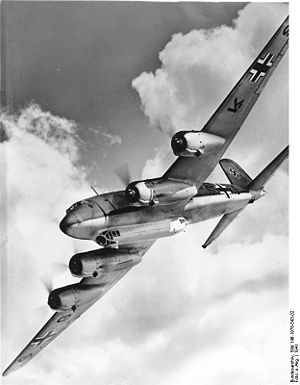 (Picture:
Focke-Wulf Fw 200)
(Picture:
Focke-Wulf Fw 200)
Role: Airliner, reconnaissance, bomber and transport aircraft
Manufacturer: Focke-Wulf
First flight: 27 July 1937
Primary users: Luftwaffe, Lufthansa, Sindicato Condor
Number built: c. 275
The Focke-Wulf Fw 200 Condor was a German all-metal four-engine monoplane that entered service as an airliner. Later versions for the Luftwaffe were used as long-range reconnaissance and anti-shipping bomber aircraft as well as transport planes for troops and VIPs.
Design and development
The Fw 200 was built to a Lufthansa specification with Wilhelm Bansemir as project director. It first flew in July 1937 after just under one year of development with Kurt Tank at the controls. The aircraft was a simple development of a pre-war commercial craft. It was an all-metal construction, four-engined monoplane capable of carrying 25 passengers up to 3,000 km (1,860 mi).
To adapt it for wartime service, hardpoints were added to the wings for bombs, the fuselage was extended and strengthened to create more space, and front, aft and dorsal gun positions were added. The extra weight of the improvements meant that a number of early Fw 200 would break-up on landing, a problem that was never entirely fixed. Later models were equipped with radar.
Operational history
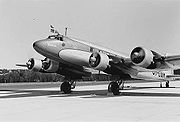 (Picture:
Danish Fw 200 airliner Dania at Fornebu Airport in Norway in 1939)
(Picture:
Danish Fw 200 airliner Dania at Fornebu Airport in Norway in 1939)
The Fw 200 was the first airplane to fly nonstop between Berlin and New York City, making the journey on August 10, 1938 in 24 hours and 56 minutes. The return trip on August 13, 1938 took 19 hours and 47 minutes. These flights are commemorated with a plaque in the Böttcherstraße street of Bremen.
A Danish Fw 200 aircraft named Dania was seized by the British on English soil after Denmark was invaded by German forces in 1940. It was operated by the British Overseas Airways Corporation (BOAC) and was later pressed into service with the British Royal Air Force. It was damaged beyond repair in 1941.
The Japanese Navy requested a military version of the Fw 200 for search and patrol duties, so Tank designed the Fw 200 V10 with military equipment. This plane was held in Germany because war had broken out in Europe by that time. This airplane became the basis for all later military models used by the Luftwaffe.
The Luftwaffe initially used the aircraft to support the Kriegsmarine, making great loops out across the North Sea and, following the fall of France, the Atlantic Ocean. The aircraft undertook maritime patrols and reconnaissance, searching for Allied convoys and warships that could be reported for targeting by U-boats. The Fw 200 could also carry a 900-kilogram (2,000 lb) bomb load, or naval mines, to use against shipping, and it was claimed that from June 1940 to February 1941, they sank 331,122 tonnes (365,000 tons) of shipping despite a rather crude bombsight arrangement. The attacks were carried out at extremely low altitude in order to "bracket" the target ship with three bombs; this almost guaranteed a hit. Winston Churchill called the Fw 200 the "Scourge of the Atlantic" during the Battle of the Atlantic due to its contribution to the heavy Allied shipping losses.[1]
From mid-1941, the aircraft were instructed to avoid attacking shipping and avoid all combat in order to preserve numbers. In August, the first Fw 200 was shot down by a CAM ship-launched Hawker Hurricane, and the arrival of the U.S.-built F4F Wildcat, operating from the Royal Navy's new escort carriers, was a serious threat. In August 1942, a Fw 200C-3 was the first German aircraft to be destroyed by USAAF pilots, after it was attacked by a P-40C and a P-38F over Iceland.
The Fw 200 was also used as a transport aircraft, notably flying supplies into Stalingrad in 1942. After late-1943, the Fw 200 came to be used solely as a transport aircraft. For reconnaissance, it was replaced by the Junkers Ju 290 and, as France was invaded, maritime reconnaissance became impossible. Production ended in 1944 with a total of 276 aircraft produced.
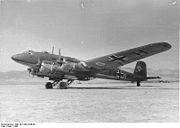 (Picture:
Fw 200 in Greece, circa 1941)
(Picture:
Fw 200 in Greece, circa 1941)
Several damaged Fw 200 landed in Spain during the war. In the beginning, they were repaired and returned to their bases in France, but after Operation Torch (Allied invasion of Africa), the Spanish government interned the four aircraft that arrived (but crews were still allowed to return to Germany). Since the planes could not be used, they were sold by Germany to Spain, and only one of the three flyable planes operated in the Spanish Air Force; spares were obtained from the other airplanes. Due to damages, lack of spares, and for political reasons, they were grounded and scrapped around 1950.
Some crashed in Portugal. Crews were allowed to return to Germany while the British authorities were allowed to inspect the aircraft and accompanying documentation. Some crews (at least one full crew) died in these crashes and all crew members are buried in the civilian cemetery of Moura (Alentejo Province) in Portugal. The aircraft that crashed both in Spain and in Portugal were based in France, in Bordeaux-Merignac (after 1940). Before 1940, the operational base of the Fw 200 squadrons was in Denmark.
Hitler Personal Transport
At the suggestion of his personal pilot Hans Baur, Adolf Hitler specified a modified and unarmed prototype Condor, the Fw 200 V1 as his personal transport, in replacement for his Junkers Ju 52. Originally configured as a 26-passenger Lufthansa transport (Works No. 3099), the plush aircraft was reconfigured as a two-cabin aircraft. Hitler's seat in the cabin was equipped with a wooden table, back-armour plating, and an automatic parachute with downward throws - although according to Baur, it was never armed. In line with Hitler's aircraft preferences, it carried the markings "D-2600" and named "Immelmann III." As the war progressed it changed designation to "WL+2600" and finally "26+00;" it was destroyed at Berlin Tempelhof Airport in an Allied bombing raid on July 18, 1944.
Variants
There were three versions of the aircraft: the Fw 200A, B, and C. The Model A was a purely civilian plane used by Lufthansa, DDL in Denmark, and Syndicato Condor in Brazil. The Fw 200B and Fw 200C models were used as long-range bombers, reconnaissance, troop and transport planes.
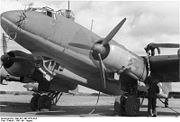 (Picture:
The radar-equipped Fw 200 C-4)
(Picture:
The radar-equipped Fw 200 C-4)
Fw 200 V1
First prototype.
Fw 200 V10
Military prototype.
Fw 200 A-0
Pre-production batch of fourth to ninth prototypes.
Fw 200 B-1
Transportation aircraft fitted with four BMW 132Dc engines.
Fw 200 B-2
Transportation aircraft fitted with four BMW 132H engines.
Fw 200 C-0
Pre-production batch of 10 aircraft, structural strengthening, the first four were manufactured as unarmed transports, the remaining six were fitted
with armament.
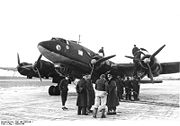 (Picture:
The radar-equipped Fw 200)
(Picture:
The radar-equipped Fw 200)
Fw 200 C-1
First military production version, BMW 132H engines, lengthened ventral gondola, increased defensive armament, provisions for four 250 kg (550
lb) bombs.
Fw 200 C-2
Similar to C-1, but featured a ‘cutaway’ outboard engine nacelles which reduced drag and could carry a 250 kg (550 lb) bomb or a 300
L (80 US gal) drop tank.
Fw 200 C-3
Structurally strengthened, fitted with Bramo 323 R-2 radial engines.
Fw 200 C-3/U1
Featured an increased defensive armament, a 15 mm MG 151 cannon in a powered dorsal turret, the 20 mm MG FF replaced by a MG 151/20 cannon.
Fw 200 C-3/U2
Fitted with original dorsal turret, and had the 20 mm MG 151/20 replaced with a 13 mm (0.5 in) MG 131 machine gun, which allowed space for the
installation of a Lotfe 7D bombsight.
Fw 200 C-3/U3
Fitted with two additional 13 mm MG 131s.
Fw 200 C-3/U4
Had 7.92 mm (0.31 in) MG 15 machine gun replaced by 13 mm MG 131s and carried an extra gunner.
Fw 200 C-4
Similar to C-3, but carried FuG Rostock search radar, late production aircraft used FuG 200 Hohentwiel radar.
Fw 200 C-4/U1 (Werk-Nr 137)
High-speed transport aircraft, only one example built. Used to transport Heinrich Himmler, Adolf Hitler and Karl Dönitz.[2]
Fw 200 C-4/U2 (Werk-Nr 138)
High-speed transport aircraft, with accommodation for 14 passengers, only one example built.[2]
Fw 200 C-6
Several aircraft were modified to carry Henschel Hs 293 missiles and re-designated C-6.
Fw 200 C-8
Fitted with FuG 203b Kehl III missile control equipment and fitted with Hs 293 missiles.
Fw 200 S-1
Special designation for Fw 200 V1 that was flown from Berlin to Tokyo.
Survivors
Only one relatively complete Fw 200 exists today. This aircraft was raised from the Trondheimsfjorden in Norway in the late 1990s. Despite disintegrating on recovery, the remains were transported to the Technical Museum in Berlin to be rebuilt there. A request from the museum for a set of separate wings to be recovered from the mountain Kvitanosi near Voss in Norway to complete the rebuild was denied, as a result of the local population wanting the wings to be left in situ as a war memorial.
Operators
Civil operators
Flag of Brazil.svg Brazil
Syndicato Condor S/A
Flag of Denmark.svg Denmark
DDL
Flag of Germany 1933.svg Germany
Lufthansa
Flag of the United Kingdom.svg United Kingdom
BOAC
Military operators
Flag of Germany 1933.svg Germany
Luftwaffe
Flag of the Soviet Union.svg Soviet Union
Soviet Air Force (post-war captured)
Flag of Spain.svg Spain
Spanish Air Force (Interned)
Flag of the United Kingdom.svg United Kingdom
Royal Air Force (one aircraft impressed)
Specifications (Fw 200C-3/U4)
General characteristics
Crew: 5
Capacity: 30 fully-armed troops in transport configuration
Length: 23.5 m (77 ft 1 in)
Wingspan: 32.8 m (107 ft 7 in)
Height: 6.3 m (20 ft 8 in)
Wing area: 118 m² (1,270 ft²)
Empty weight: 12,950 kg (28,550 lb)
Max takeoff weight: 22,700 kg (50,000 lb)
Powerplant: 4× BMW/Bramo 323R radial engines, 895 kW (1,200 hp) each
Performance
Maximum speed: 360 km/h at 4,800 m (224 mph at 15,750 ft)
Range: 3,556 km combat; 4,440 km ferry (2,210 mi ; 2,760 mi)
Service ceiling: 5,800 m (19,000 ft)
Armament
2 × 20 mm MG 151/20 cannons
6 × 7.92 mm MG 15 machine guns
1 × 13 mm MG 131 machine gun
Up to 3,000 kg (6,600 lb) of bombs
References
1. The Illustrated History of the German Air force in WWII- Dr. John Pimlott - Motorbooks International
2. a b Wings of the Luftwaffe, p. 15
Living Warbirds: The best warbirds DVD series.
Source: WikiPedia